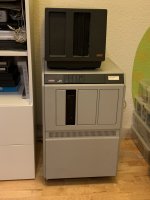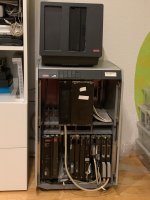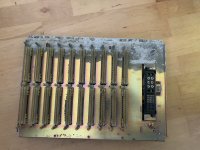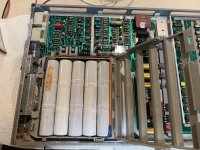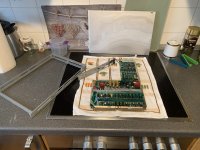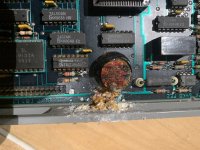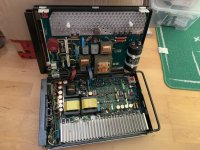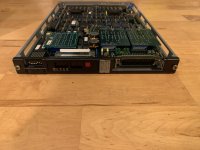So Nixdorf liked using Racal and Quattro (which were just badged by them) modems.
I think they were set for 1200 baud with 1 start, 8 data and 2 stop bits giving an 11 bit word. I know that over the years we tried to use other much cheaper modems and could never configure them correctly.
They were just starting to move to 2400 baud but as far as I know, 1200 remained the most common; in the UK anyway.
In Germany I think everything was basically ISDN.
As you've seen your chassis has two backplanes. The bottom one is the logic backplane, and the top is a peripheral one. The two backplanes don't really interconnect except for power and I think a couple of control signals. This is deliberate to make the chassis and backplanes reusable for different machines.
As it happens the M25 machine is different from most 8870's in that it only has one PSU on the lower logic tier. Most 8870's have a PSU on each tier; be it logic or peripheral. The M25 (and the horrible M15) were designed as small office machines so had smaller backplanes than larger 8870s (M45, M75 etc).
All backplanes have IDC connectors on the edge that allow them to be daisy chained to other tiers or connected to controller plates. There should be a cable that runs from the peripheral tier backplane, down the edge, under the logic tier cage and up into to the front of the disk controller. The SMC drive only gets its power from the backplane; all the control signals are routed via the data cable that comes out the front of the SMC and plugs into the disk/SMC controller plate.
Finding a working DAP4 will be a challenge, and one where the lithium backup battery hasn't leaked and eaten everything even more so. However, you may be lucky. Also, like everything Nixdorf did, looks can be deceiving. A DAP4 is really just a chassis with a CRT. What makes it 8870 compatible is the PSU and processor board installed. The DAP4 was probably the most popular VDU Nixdorf did and whilst they look identical, they will have a different processor plate installed depending on the target system. In the UK that could be for an 8812, 8850, 8860, 8870, 8890. There are also some differences around the keyboards. If the keyboard has provision to accept metal security keys down the right hand side for example, it's probably not an 8870 keyboard so probably not an 8870 DAP4. But there are always exceptions. One of the DAP4s I had on my desk had one of these security keyboards. Needless to say, a DAP4 from one series of machine won't work (without a replacement CPU plate and possibly replacement PSU) on another series machine.
It may sound confusing but everything Nixdorf did was modular. In the UK the banks and building society's used 8860 BNC machines. The chassis for the 8860 BNC was never sold (in the UK) for anything other than 8860 use due to it's physical dimensions, but change the processor plate, remove a couple of the plates used for communications, add an ALME and chance a couple of jumps on the logic backplane and you had a working 8870 chassis. Engineers didn't have to carry spare, bulky and heavy VDUs around with them, just a selection of replacement PSU's and CPU plates. It was rare that a CRT actually failed.
And as you've probably realised, changing a CPU or any plate is a piece of cake. Pull the faulty one, slam in the replacement, make sure the 8 DIP switches at the top are set the same and away you go. PLC's and ALME's had some personality boards that needed to be swamped over, but it was all plug and play. An engineer could get pretty much any Nixdorf machine up and running again very quickly. Actually that's only true once they moved to self contained disk drives. The earlier machines used SMD, Hawk(Diablo) and Phoenix drives, and drive servicing and fixing head crashes was a time heavy job.
Whilst I remember, you can start the system with no plates installed to test the PSU. Remove disks and all plates, and flick the switch in the PSU up (I think). It should come on and and give you all good status indicators. If you move the switch back to the centre position it will power off because it's not receiving a NEN signal. But it's a good way to test that the PSU is working. You can then poke around the backplane and measure the voltages.
On last thing. It's not uncommon to find an 8870 that looks like it's spent it's life living in a dustbin. They are typically full of dust, paper clips, dead mice and heaven knows what. The reason is that Nixdorf machines didn't need air conditioning; that was a big selling point. Once they moved to machines with self contained disk drives it was very common to find an M45 or M25 sat in the corner of an office or under somebodies desk just humming away to itself. You probably already have, but you need to open up every plate; remove the front and back covers, and remove all the dust and much. Likewise the top of each tier has sets of fan modules. These need to be removed and cleaned. If you get the fan failure LED and buzzer sounding the system will auto shutdown; assuming the operating system is running. Just start disconnecting the fans till you find the faulty one.
I really miss playing with these machines.
Regards,
Joe
